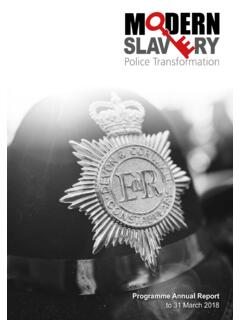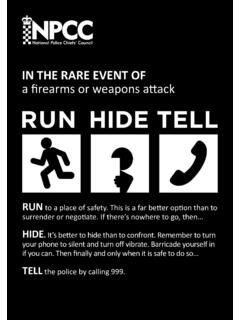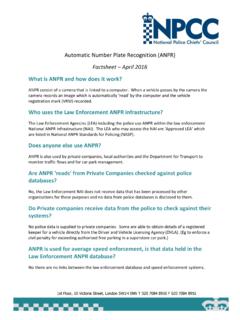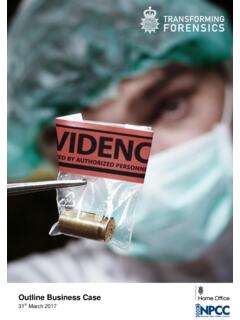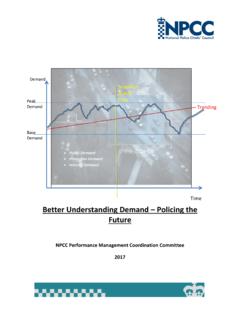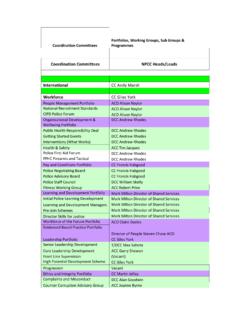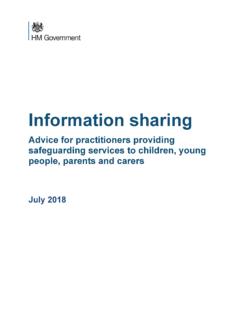Transcription of WHEN TO CALL THE POLICE
1 WHEN. TO CALL. THE POLICE . Guidance for schools & colleges INTRODUCTION. Who is this for? Chapter 1 of working together to safeguard children explains POLICE assistance is required that the safeguarding partners should publish a threshold This advice is for school and college staff with responsibility document that should include the criteria, including the level All other non-emergency incidents should be reported for behaviour management, including designated safeguarding of need, for when a case should be referred to local authority using 101 or online reporting methods, or through existing leads (DSLs)
2 , their deputies, head teachers and senior children 's social care for assessment arrangements, for example, to a safer schools officer. The call leadership teams in schools and colleges in England. and for statutory services under section 17 and 47 of the will be logged by an operator and depending on the nature of children 's Act 1989. the incident the appropriate response made. What does this advice cover? Local authorities, with their partners, should develop and Contact with POLICE should ideally be made by a single point of This advice covers incidents on school and college premises publish local protocols for assessment.
3 A local protocol should contact from the school. This may be the headteacher or the where students have potentially committed a crime. It provides set out clear arrangements for how cases will be managed once designated safeguarding lead. Every school and college should guidance on what schools and colleges should bear in mind a child is referred into local authority children 's social care. have a designated safeguarding lead who will provide support when considering contacting the POLICE . This advice covers the to staff to carry out their safeguarding duties and who will liaise following situations: Sexual offences closely with other services such as children 's social care.
4 The designated safeguarding lead (and any deputies) are most likely Assault In the case of incidents involving sexual offences, schools and to have a complete picture of safeguarding and be the most Criminal damage colleges should refer to local safeguarding protocols, alongside appropriate person to advise on the response to safeguarding Cyber crime Keeping children safe in education and Sexual violence and concerns. Drugs harassment between children in schools and colleges guidance. Harassment Having a single point of contact between a school or college Sexual offences In cases involving youth produced sexual imagery often called and the POLICE helps increase consistency in referrals.
5 Theft sexting' - schools and college may refer to the non-statutory Weapons UKCCIS sexting in schools and colleges guidance. This advice aims to support schools and college to make What is the status of this advice? Contacting the POLICE defensible decisions when considering whether to involve the In an emergency dial 999. This should be used if: POLICE . This advice has been produced by the National POLICE Chiefs'. Council working alongside the Department for Education, - There is a danger to life or safeguarding incidents Home Office and the PSHE Association.
6 - Risk of serious injury or - A serious crime is in progress or about to happen. This advice does not cover safeguarding incidents. Where a This advice is non-statutory and should be read alongside child is suffering, or is likely to suffer from harm, it is important the Department for Education's (DfE) keeping children safe Any member of staff witnessing such an incident should that a referral to children 's social care (and if appropriate the in education statutory guidance and non-statutory searching, be empowered to dial 999 as they will be able to give POLICE ) is made immediately.
7 Referrals should follow the local Screening and Confiscation advice for schools. the most accurate account of the incident. referral process. 2. Making a decision to involve Any aggravating factors which contribute to making the Vulnerable young people the POLICE incident and subsequent level of harm more serious would be relevant in making a decision on whether or not to involve the All staff should be prepared to identify children and young When an incident occurs in which a crime has or may have POLICE . people who may benefit from early help.
8 Early help means been committed, the school or college need to consider providing support as soon as a problem emerges at any point in whether to involve the POLICE . Many incidents can be dealt Ideally the decision as to whether the school or college deal a young person's life, from the foundation years through to the with and resolved internally. The school or college behaviour with an incident internally or pass it over to the POLICE needs teenage years. policy will give guidance on how to deal with and record such to be made at the initial stage, by gathering only enough incidents.
9 Information to establish the facts of the case. Some areas of vulnerability are highlighted below, but should not be seen as a comprehensive list. It's important to note that This guidance document outlines the factors which school or The school or college should be aware that they may not be most children and young people with vulnerabilities do not college leaders should consider when deciding to involve the aware of all circumstances leading to or connected to the commit offences. POLICE . These considerations would inform whether the POLICE incident students behaviour or involvement outside school would expect and need to be involved.
10 Or within their family. Contacting the POLICE or other agencies However, the challenges that children and young people may allow a further picture to be obtained, which assists in with vulnerabilities are facing can sometimes contribute All concerns, discussions and decisions made, and the reasons making informed decisions. to behaviour which may lead them to unwittingly commit for those decisions, should be recorded in writing. If in doubt offences. about recording requirements, staff should discuss with the When the decision is made that the school or college will deal designated safeguarding lead (or deputy).

